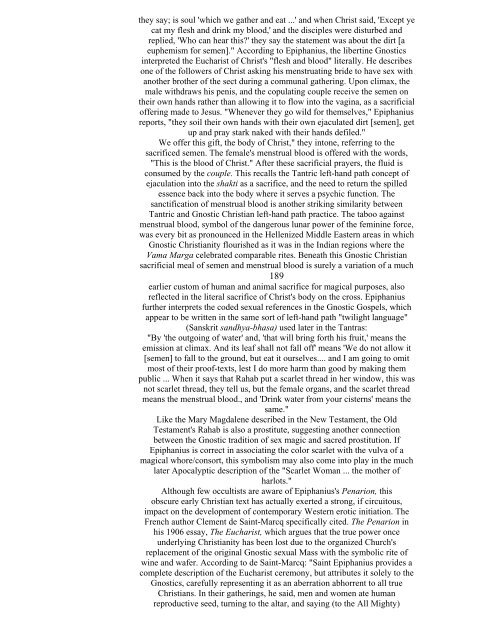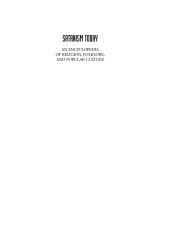I. VAMA MARGA Foundations Of The Left-Hand Path - staticfly.net
I. VAMA MARGA Foundations Of The Left-Hand Path - staticfly.net
I. VAMA MARGA Foundations Of The Left-Hand Path - staticfly.net
Create successful ePaper yourself
Turn your PDF publications into a flip-book with our unique Google optimized e-Paper software.
they say; is soul 'which we gather and eat ...' and when Christ said, 'Except ye<br />
cat my flesh and drink my blood,' and the disciples were disturbed and<br />
replied, 'Who can hear this?' they say the statement was about the dirt [a<br />
euphemism for semen]." According to Epiphanius, the libertine Gnostics<br />
interpreted the Eucharist of Christ's "flesh and blood" literally. He describes<br />
one of the followers of Christ asking his menstruating bride to have sex with<br />
another brother of the sect during a communal gathering. Upon climax, the<br />
male withdraws his penis, and the copulating couple receive the semen on<br />
their own hands rather than allowing it to flow into the vagina, as a sacrificial<br />
offering made to Jesus. "Whenever they go wild for themselves," Epiphanius<br />
reports, "they soil their own hands with their own ejaculated dirt [semen], get<br />
up and pray stark naked with their hands defiled."<br />
We offer this gift, the body of Christ," they intone, referring to the<br />
sacrificed semen. <strong>The</strong> female's menstrual blood is offered with the words,<br />
"This is the blood of Christ." After these sacrificial prayers, the fluid is<br />
consumed by the couple. This recalls the Tantric left-hand path concept of<br />
ejaculation into the shakti as a sacrifice, and the need to return the spilled<br />
essence back into the body where it serves a psychic function. <strong>The</strong><br />
sanctification of menstrual blood is another striking similarity between<br />
Tantric and Gnostic Christian left-hand path practice. <strong>The</strong> taboo against<br />
menstrual blood, symbol of the dangerous lunar power of the feminine force,<br />
was every bit as pronounced in the Hellenized Middle Eastern areas in which<br />
Gnostic Christianity flourished as it was in the Indian regions where the<br />
Vama Marga celebrated comparable rites. Beneath this Gnostic Christian<br />
sacrificial meal of semen and menstrual blood is surely a variation of a much<br />
189<br />
earlier custom of human and animal sacrifice for magical purposes, also<br />
reflected in the literal sacrifice of Christ's body on the cross. Epiphanius<br />
further interprets the coded sexual references in the Gnostic Gospels, which<br />
appear to be written in the same sort of left-hand path "twilight language"<br />
(Sanskrit sandhya-bhasa) used later in the Tantras:<br />
"By 'the outgoing of water' and, 'that will bring forth his fruit,' means the<br />
emission at climax. And its leaf shall not fall off' means 'We do not allow it<br />
[semen] to fall to the ground, but eat it ourselves.... and I am going to omit<br />
most of their proof-texts, lest I do more harm than good by making them<br />
public ... When it says that Rahab put a scarlet thread in her window, this was<br />
not scarlet thread, they tell us, but the female organs, and the scarlet thread<br />
means the menstrual blood., and 'Drink water from your cisterns' means the<br />
same."<br />
Like the Mary Magdalene described in the New Testament, the Old<br />
Testament's Rahab is also a prostitute, suggesting another connection<br />
between the Gnostic tradition of sex magic and sacred prostitution. If<br />
Epiphanius is correct in associating the color scarlet with the vulva of a<br />
magical whore/consort, this symbolism may also come into play in the much<br />
later Apocalyptic description of the "Scarlet Woman ... the mother of<br />
harlots."<br />
Although few occultists are aware of Epiphanius's Penarion, this<br />
obscure early Christian text has actually exerted a strong, if circuitous,<br />
impact on the development of contemporary Western erotic initiation. <strong>The</strong><br />
French author Clement de Saint-Marcq specifically cited. <strong>The</strong> Penarion in<br />
his 1906 essay, <strong>The</strong> Eucharist, which argues that the true power once<br />
underlying Christianity has been lost due to the organized Church's<br />
replacement of the original Gnostic sexual Mass with the symbolic rite of<br />
wine and wafer. According to de Saint-Marcq: "Saint Epiphanius provides a<br />
complete description of the Eucharist ceremony, but attributes it solely to the<br />
Gnostics, carefully representing it as an aberration abhorrent to all true<br />
Christians. In their gatherings, he said, men and women ate human<br />
reproductive seed, turning to the altar, and saying (to the All Mighty)
















